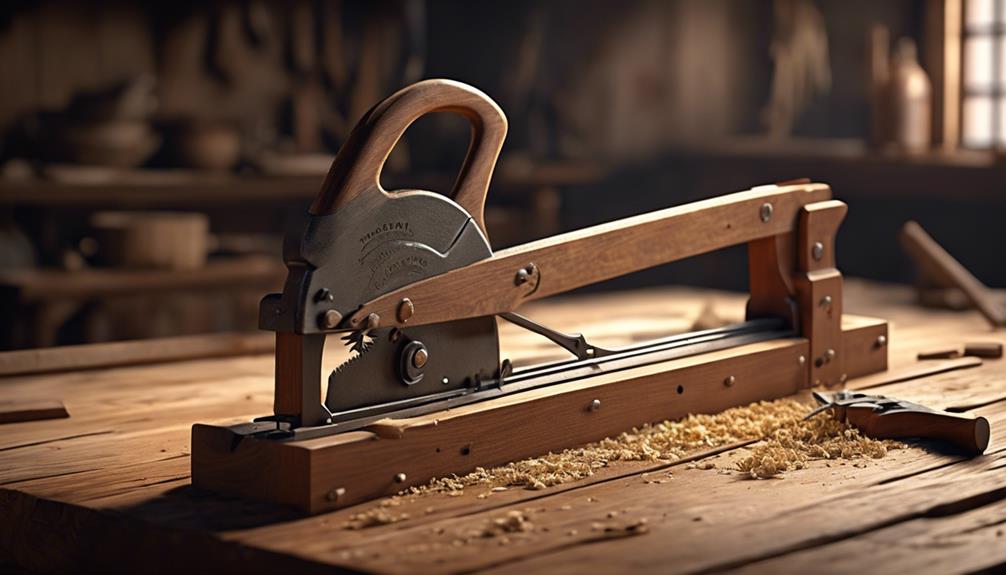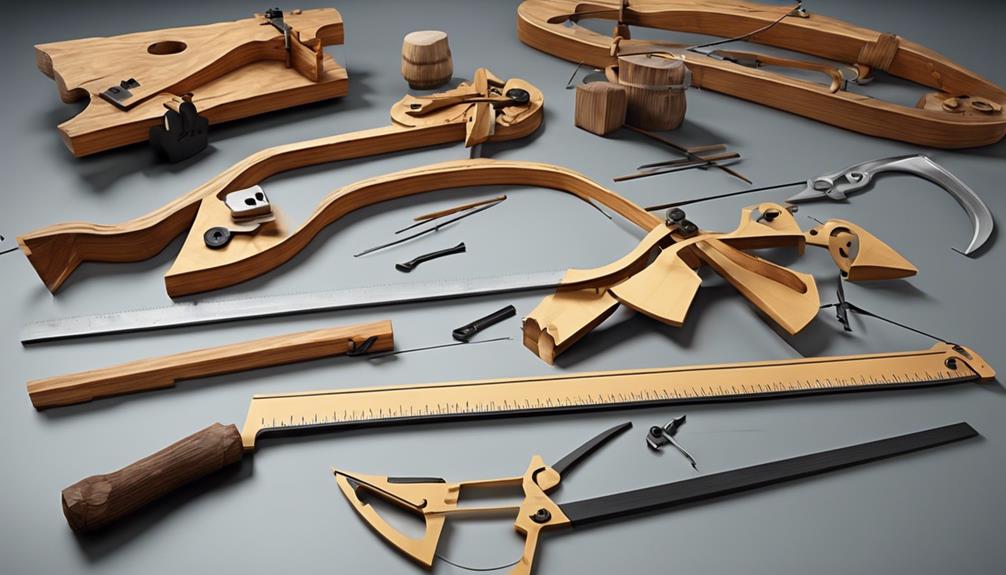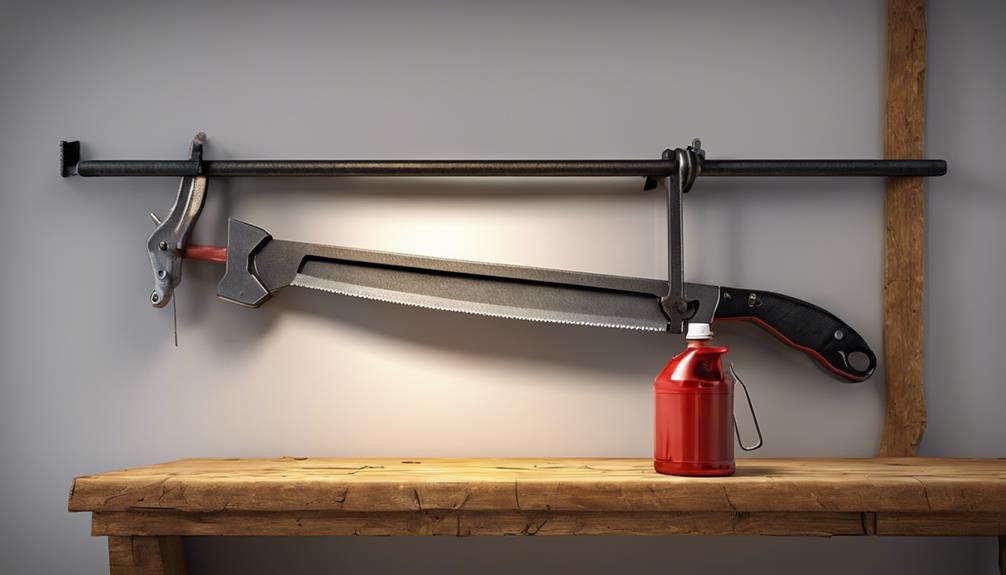Explore the world of bow-shaped woodworking tools, like the traditional bow saw, coping saw, turning saw, and frame saw, each with unique advantages for your projects. These tools provide unparalleled precision, clean cuts, and smooth finishes. Learn proper usage techniques, from grip to blade positioning, to maximize efficiency. Maintenance tips, like sharpening and lubrication, guarantee your tool's longevity. Discover how advancements in metallurgy have enhanced blade durability and made bow saws symbols of skill and artisan craftsmanship. Master the art of woodworking with these versatile and indispensable tools.
Key Takeaways
- Traditional bow saw for cutting green wood efficiently and precisely.
- Coping saw ideal for intricate work and curved cuts in woodworking.
- Turning saw for straight and curved cuts, versatile for various projects.
- Frame saw for resawing and cutting large boards with ease.
- Each type offers unique benefits tailored to specific woodworking needs.
History of the Bow Saw

The history of the bow saw dates back to ancient civilizations, where it played an essential role in woodworking tasks. The evolution of design in bow saws can be traced through various cultures and time periods. Initially, these saws had a simple construction, consisting of a curved wooden or metal frame with a taut blade. Over time, advancements in metallurgy led to the production of more durable blades, enhancing the saw's cutting efficiency and longevity.
Cultural significance of the bow saw is profound, as it wasn't only a tool but also a symbol of craftsmanship and skill. In medieval Europe, for example, bow saws were commonly used by artisans and carpenters to create intricate woodwork for cathedrals and castles. The precision and versatility offered by the bow saw made it indispensable in shaping wood for furniture, tools, and architectural elements.
As civilizations progressed, so did the design of the bow saw. Different regions developed their unique variations, incorporating local materials and craftsmanship techniques. This diversity in design not only showcases the ingenuity of past societies but also highlights the universal need for efficient woodworking tools. The bow saw's enduring presence in history reflects its adaptability and functionality across various cultures and time periods.
Advantages of Using a Bow Saw
Occasionally, utilizing a bow saw provides woodworkers with unparalleled precision and control when cutting various materials. The cutting precision offered by a bow saw is exceptional, allowing you to make intricate cuts with ease.
The design of the bow saw, with its curved blade, enhances its efficiency in woodworking tasks. This curved blade enables you to maneuver through tight spaces and around curves, making it a versatile tool for a wide range of cutting needs.
The efficiency of a bow saw lies in its ability to deliver clean and accurate cuts, whether you're working on intricate designs or simply need straight cuts. The curved blade allows for greater control over the cutting process, reducing the chances of errors and ensuring a smooth finish on your woodworking projects.
This level of control is especially beneficial when working with delicate or expensive materials, where precision is key to the success of the project.
Types of Bow-Shaped Woodworking Tools

When exploring types of bow-shaped woodworking tools, consider the various options available for enhancing your woodworking projects with precision and versatility.
Bow saws are versatile tools that come in different designs to suit various DIY projects and woodworking techniques. One common type is the traditional bow saw, featuring a narrow, coarse-toothed blade ideal for cutting green wood quickly. This type is excellent for rough shaping and cutting large branches.
For more intricate cutting tasks, consider a coping saw. This type of bow-shaped tool has a thin blade held in place by a C-shaped frame, making it perfect for detailed work like cutting curves and intricate patterns in wood. Coping saws are a staple for fine woodworking projects that require precision cuts.
If you're looking for a bow-shaped tool that can handle both straight cuts and curved lines, a turning saw is a great option. This tool features a long, narrow blade that can be rotated to cut in different directions, providing flexibility for various woodworking techniques.
Lastly, for those interested in working on larger DIY projects or cutting thicker wood, a frame saw might be the best choice. Frame saws have a wider blade tensioned within a wooden frame, making them suitable for resawing and cutting large boards accurately.
Each type of bow-shaped woodworking tool offers unique benefits for enhancing your woodworking skills and achieving precise results in your projects.
How to Properly Use a Bow Saw
To properly use a bow saw for woodworking projects, make sure that you have a secure grip on the handle and position the blade correctly before beginning your cut. When gripping the handle, guarantee your hand is firm but not overly tight to maintain control during the cutting process.
Position the blade so that it's perpendicular to the wood surface, allowing for a smooth and efficient cut.
When using a bow saw, it's essential to follow specific techniques to achieve the best results. Maintain a steady pace while cutting, allowing the blade to do the work without forcing it through the wood. Keep the saw straight and avoid twisting it, as this can lead to an uneven cut. Additionally, use the full length of the blade to maximize cutting efficiency.
Common mistakes when using a bow saw include applying too much pressure, which can cause the blade to bind or break. Avoid pushing the saw too forcefully and let the blade move through the wood at its own pace.
Moreover, failing to secure the workpiece properly can result in instability and potential accidents.
To guarantee safety when using a bow saw, always wear protective gear such as gloves and safety goggles. Maintain a clear workspace free of clutter to prevent tripping hazards. Best practices include keeping the blade sharp and properly tensioned for top cutting performance. Remember to store the bow saw in a safe place when not in use to prevent accidents and prolong its lifespan.
Tips for Maintaining Your Bow Saw

Proper maintenance of your bow saw is essential for guaranteeing its longevity and peak performance in woodworking projects. To keep your bow saw in top condition, regular maintenance, sharpening, and lubrication are key.
Start by inspecting the saw frame for any signs of damage or wear. Check the blade tension by plucking it like a guitar string; it should produce a clear, consistent sound. If the tension is off, adjust it using the tensioning mechanism on the saw.
When it comes to sharpening your bow saw, use a triangular file to sharpen each tooth individually. Maintain a consistent angle and pressure to ensure a uniform sharpness across all teeth.
Lubricate the blade periodically to prevent rust and ensure smooth cutting. You can use a silicone-based lubricant or even beeswax for this purpose.
If you encounter issues with your bow saw, such as the blade wandering during cuts or difficulty in cutting, troubleshooting is necessary. Check the blade alignment and tension first. If everything seems correct, inspect the teeth for dullness or damage. Additionally, make sure the blade is properly lubricated to reduce friction.
Conclusion
To sum up, the bow-shaped woodworking tool, known as the bow saw, has a rich history and offers many advantages for cutting wood. Understanding the different types of bow saws and how to properly use and maintain them will guarantee efficient and effective woodworking projects.
With its unique design and versatility, the bow saw is a valuable tool for both professional woodworkers and DIY enthusiasts alike.
